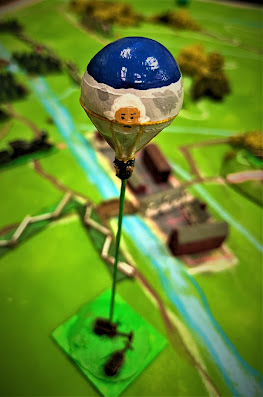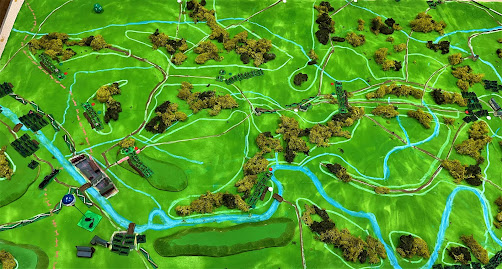The Battle of the Alma (1854) is one of the best-known battles of the Crimean War. A scan of wargame forums suggests it is fought reasonably regularly. Unfortunately it tends to be treated as a dull frontal assault: across the river, up the slope, into the teeth of the Russian guns and massed columns. Some people enjoy games like that; I prefer to have more choices to make.
So, when I came to write the Alma scenario for the "Bloody Big European Battles!" scenario book, I tried to make it more interesting. I looked at the options available to the Russians and saw that a viable alternative strategy for them might have been to deploy further east and threaten the allies' flank, rather than directly barring their way to Sevastopol. Meanwhile, as I recall, there was some argument between the allies, with the French keen to press forward as swiftly as possible and the British being more cautious.
The scenario therefore gives both sides the opportunity to choose between their two options, resulting in four possible permutations of aims and victory conditions. A direct recreation of history is one possible outcome. However, when we fought the Alma this month using Matt's gorgeous display game layout, the result was a kind of 'alternative Alma' in which the action was somewhat displaced from its historical location but still very much captured the flavour.
The Russian team chose the 'flank position', while the allies opted for 'cautious'. This meant the allies had to deal with the flank threat before advancing on Sevastopol, so they had 8 turns to drive the Russians back along their line of the communications to the southeast. (Had the allies chosen 'aggressive', they would have focused on exiting French units off the south board edge, while preventing Russians descending towards the allies' supplies piled on the beach behind them.) I was on the allied side in the minor role of commander of the Turkish division.
After the first few turns it looked dire for the allies, thanks to aggressive Russian defence and bad allied dice. The allies had advanced in march columns so as to get through the vineyards and across the river as quickly and easily as possible. Unfortunately, Russian attack columns pounced on the British as they ascended the far slope and gave them a very bloody nose, effectively putting one division out of action. As for the French, they repelled the Russian onslaught but dismal movement dice then had them sitting around for coffee and croissants for a couple of hours. I thought we were set for humiliating defeat.
But of course, as the game went on, the Russian hordes melted away in the face of superior allied firepower. The British cleared the road between Kanysch and Uleschel (our first objective), and French panache and elan were carrying the zouaves and friends far into the Russian left. On the last turn we even had a chance of seizing the next stretch of road for an unlikely win. Equally, a late Russian counterattack could have claimed victory for the Tsar.
Of course it wasn't to be and the game ended as an honourable draw. Well played to all my gallant comrades and opponents alike.
Three captioned photos below are followed by some reflections.
View of Matt's gorgeous layout from the Black Sea. Terrain boards with custom hills; the mosque in Bourliouk (top centre); the half-built telegraph tower (top right); the allied fleet of steam & sail warships - note the smoke coming out of their funnels. It really was fabulous work and a privilege to push troops across it.
Situation circa Turn 2. French on the right have dashed across the bridge at Bourliouk; British on the left make slower progress because the Russians have set light to Kanysch (centre left of pic - Matt actually had flickering flames). Russian columns menace from top of pic. In the foreground, my Turkish division snakes from right to left to support the British. Beautiful figures on beautiful terrain.
Close-up of the British columns fording the Alma. Highlanders on the right following the guards' bearskins. The division top left is about to be sent reeling back with heavy casualties.
Reflections:
Similar but different. Interestingly, even though the Russian choice of flank threat rather than historical blocking position shifted most of the action away from the historical battlefield, it still captured much the same historical flavour. We still had Brits battling their way across the river and up steep bluffs against massed Russian counterattacks and formidable artillery redoubts; we still had French bogged down for a while until the zouaves went on a big right hook.
Gorgeous game. I can't overstate how much work Matt had put into the terrain, the troops, the fleets and the counters (low ammo, disruption etc were all appropriate little models). Consequently the game looked great, which helps to make our mental pictures more vivid as well, and to tell the story of the battle.
Quality vs Quantity. Asymmetry makes for interesting match-ups. The contrast between the Russian army (Tactically Inept, not great musketry but plenty of artillery) and the allies (lots of longer-ranged rifles, capable skirmishers, hence deadly small arms fire) was dramatic. The Russians did a good job of exploiting such advantages they had, but ultimately quality told and changed the course of the game.
Dice can stink! I have rarely seen so many pairs of snake-eyes as Phil rolled for the French, paralysing their advance for half the game. One can rationalise that as the French commander being taken aback by the Russian aggression and pausing, unsure what more might be over the next hill.
Hurrah for Johnny Turk. You can't see it as I didn't take many photos, but right at the end it was my Turkish division that interposed to prevent a Russian counterattack that could have snatched victory. I therefore claim all the credit for the allies' (partial) success. ;-)
The Alma scenario is one of four that form a Crimean War mini-campaign in the "Bloody Big European Battles!" scenario book: Kurudere, The Alma, Inkerman and The Chernaya. BBEB is available from all the usual BBB retailers. There is also a Balaclava scenario available free from the files of the BBB group on groups.io.











